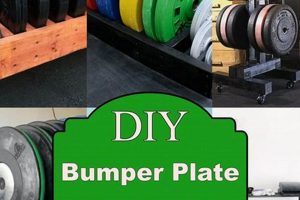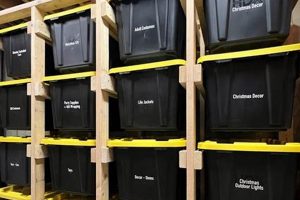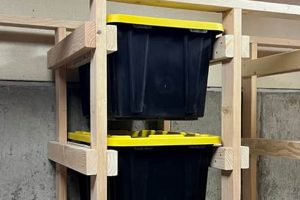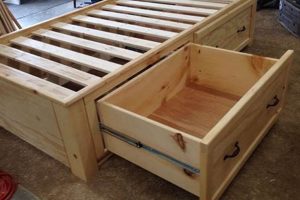Effective and sanitary containment of the flexible conduit employed for waste evacuation from a recreational vehicle represents a common challenge for RV owners. Proper management of this component prevents potential messes, controls odors, and extends the lifespan of the equipment. This practice often involves constructing a customized solution tailored to the specific dimensions and storage constraints of the individual RV.
Optimized management of the sanitation apparatus contributes significantly to the overall RV experience. By addressing the need for a secure and accessible location, potential health hazards are mitigated and the aesthetics of the vehicles storage compartments are improved. Historically, ad hoc methods were often employed, but the availability of readily available materials and adaptable designs has fostered a trend toward purpose-built, individualized systems.
The subsequent sections will delve into the materials commonly used in fabrication, various design considerations, and practical implementation strategies for constructing a personalized solution that ensures secure and hygienic handling of this essential RV component. Detailed instructions and examples of successful builds will be provided.
DIY RV Sewer Hose Storage
Effective implementation of a customized RV sewer hose containment solution requires careful planning and execution. The following tips offer guidance in designing and constructing a durable and functional system.
Tip 1: Material Selection: Prioritize durable, weather-resistant materials such as PVC pipe or heavy-duty plastic containers. UV exposure can degrade certain plastics, so opt for materials designed for outdoor use. Consider the weight of the fully loaded hose when selecting the appropriate material thickness.
Tip 2: Secure Mounting: Ensure the chosen storage method is securely affixed to the RV frame or an appropriate structural component. Utilize heavy-duty brackets, bolts, and self-tapping screws to prevent movement or detachment during transit. Proper mounting is crucial for safety and hose preservation.
Tip 3: Ventilation Considerations: Incorporate ventilation into the storage design to minimize the build-up of moisture and odors. Small drain holes or screened vents can facilitate airflow, preventing mildew and extending the hose’s lifespan. Proper ventilation improves sanitation and reduces unpleasant smells.
Tip 4: Access and Retrieval: Design the storage solution with ease of access in mind. Ensure the hose can be easily inserted and retrieved without excessive bending or straining. A hinged access panel or a slide-out design can simplify the process and reduce wear on the hose.
Tip 5: Length Accommodation: Precisely measure the fully extended length of the sewer hose to determine the necessary storage dimensions. Allow for slight extra length to avoid compression or stretching, which can damage the hose over time. Accurate measurement is crucial for functional and practical storage.
Tip 6: Consider Cleanliness: Design the container to be easily cleaned and drained. Residue can accumulate over time, leading to odors and potential contamination. Smooth internal surfaces and drainage points will ease cleaning and improve hygiene.
Tip 7: Locking Mechanisms: Implement a secure locking mechanism to prevent the hose from accidentally falling out during travel. A simple latch, a locking pin, or a screw-on cap can provide adequate security and prevent unwanted incidents.
Adherence to these guidelines during the construction of a containment system will result in a more secure, sanitary, and long-lasting solution. Careful planning and execution translate to a more pleasant and trouble-free RV experience.
The next step will address the common mistakes in sewer hose storage. Knowledge of these blunders may prevent damage to the rig and promote better sanitation.
1. Durability of Materials
The longevity and effectiveness of a customized recreational vehicle sewer hose containment depend significantly on the inherent properties of the constituent materials. The materials selected directly influence the storage solution’s resistance to environmental factors, physical stress, and chemical degradation. Premature failure of the containment structure due to material weakness can lead to unsanitary conditions, equipment damage, and increased maintenance demands. For example, using thin-walled PVC pipe that is not UV resistant in an environment with high sun exposure may lead to cracking and disintegration, exposing the hose to the elements and potentially causing breakage of the containment.
The selection process should consider factors such as impact resistance, temperature tolerance, and chemical inertness. Polyvinyl chloride (PVC) and high-density polyethylene (HDPE) are commonly employed due to their relative affordability and resistance to the chemicals typically found in RV waste systems. However, proper grade and thickness selection is crucial. Utilizing a schedule 40 PVC pipe, for instance, offers greater structural integrity compared to thinner, less robust alternatives, improving the longevity of the enclosure when exposed to vibrations and impacts inherent in RV travel. Alternatively, stainless steel provides superior durability and corrosion resistance but at a higher material cost and increased fabrication complexity. The use of low-quality, brittle plastics, on the other hand, often leads to premature failure, negating the economic benefits of the initial cost savings.
In conclusion, the durability of materials represents a foundational element in the successful construction of a containment system. A carefully considered selection process, balancing cost with necessary performance characteristics, safeguards against premature degradation, ensures sanitary operation, and minimizes long-term maintenance requirements. Overlooking material specifications compromises the entire system, leading to potentially unsanitary conditions and unnecessary expenses.
2. Mounting Security
Robust mounting is paramount for any customized recreational vehicle sewer hose containment system. The integrity of the attachment directly impacts the system’s ability to withstand the dynamic forces encountered during travel, preventing potential hazards and equipment damage. A poorly secured system poses risks to the RV itself, other vehicles, and the environment.
- Bracket Selection and Placement
The choice of mounting brackets and their strategic placement is a primary determinant of system security. Brackets must be rated to support the weight of the fully loaded hose and be compatible with both the containment material and the RV frame. Proper placement distributes the load evenly, minimizing stress points. For example, using lightweight, plastic brackets for a heavy-duty PVC pipe filled with a sewer hose is inadequate. Instead, heavy-gauge metal brackets, spaced appropriately along the length of the container, are recommended.
- Fastener Specifications and Installation
The fasteners used to attach the brackets to both the containment system and the RV frame must be appropriately sized, rated, and installed. Self-tapping screws are often used, but their holding power varies based on the substrate material. Through-bolting with locknuts provides a more secure connection, particularly for heavier systems. Failure to use the correct fasteners or improper installation, such as over-tightening which can strip threads, compromises the entire mounting system.
- Structural Integrity of Mounting Surface
The RV frame or mounting surface must possess sufficient structural integrity to support the weight and dynamic loads imposed by the containment system. Mounting to thin sheet metal or weakened areas of the frame is insufficient. Reinforcement may be necessary to distribute the load and prevent damage to the RV. An example of poor practice would be mounting the container to a corroded section of the RV’s chassis without proper inspection and reinforcement.
- Vibration Dampening and Isolation
Vibration during travel can loosen fasteners and fatigue mounting brackets. Incorporating vibration dampening materials, such as rubber isolators, between the brackets and the RV frame can mitigate these effects. This reduces stress on the mounting hardware and extends the lifespan of the system. For instance, a rubber bushing placed between the bracket and the RV frame can absorb some of the vibrational energy.
These facets of mounting security are interconnected. A well-designed system considers bracket strength, fastener selection, the integrity of the mounting surface, and vibration dampening. Neglecting any of these aspects increases the risk of system failure, underscoring the critical role mounting security plays in a successful DIY sewer hose management implementation.
3. Ventilation Effectiveness
Ventilation effectiveness within a customized recreational vehicle sewer hose containment system is a crucial factor impacting hygiene, odor control, and the lifespan of the stored hose. Inadequate ventilation fosters conditions conducive to microbial growth, accelerates material degradation, and results in unpleasant odors. Optimizing airflow within the containment structure mitigates these detrimental effects.
- Moisture Reduction
A primary function of effective ventilation is the reduction of moisture accumulation within the storage compartment. Residual moisture from the sewer hose creates a breeding ground for mold and bacteria. Ventilation facilitates evaporation, minimizing the potential for microbial proliferation. As an example, a storage tube with strategically placed vent holes will exhibit lower humidity levels compared to a sealed container, thereby inhibiting the growth of unwanted organisms.
- Odor Mitigation
Sewer hoses, even after thorough rinsing, retain residual odors. Effective ventilation allows for the dispersion of these odors, preventing their concentration within the storage area and subsequent infiltration into the RV’s living space. A system incorporating a vent with a charcoal filter can further enhance odor control by actively absorbing volatile organic compounds.
- Material Preservation
Prolonged exposure to moisture and elevated temperatures accelerates the degradation of the sewer hose material. Ventilation reduces these stresses, extending the hose’s useful life. For instance, a hose stored in a well-ventilated compartment will exhibit less cracking and stiffness compared to one stored in a sealed, unventilated environment.
- Prevention of Pressure Build-up
In warmer climates, sealed containers can experience pressure build-up due to off-gassing from the hose material. Ventilation allows for the release of these gases, preventing potential deformation of the container and minimizing the risk of bursting. Small strategically placed vent holes can allow to the gases to vent out.
The effective integration of ventilation within a custom-built sewer hose solution represents a proactive approach to RV sanitation and maintenance. By addressing moisture build-up, odor retention, material degradation, and pressure accumulation, a well-ventilated system contributes significantly to a more hygienic, comfortable, and durable RV experience. The design and implementation of ventilation mechanisms should be considered an integral part of any storage solution.
4. Accessibility Design
Accessibility design, in the context of DIY RV sewer hose storage, dictates the ease with which the hose can be deployed, retrieved, and stored. A well-designed system minimizes physical strain, reduces the risk of contamination, and enhances the overall user experience. The following facets outline critical considerations for achieving optimal accessibility.
- Hatch or Opening Dimensions
The dimensions of the access point directly impact the convenience of hose manipulation. An opening that is too small requires excessive bending or contortion to insert or remove the hose, increasing the risk of spills and physical strain. Conversely, an excessively large opening compromises the structural integrity of the containment system. Practical examples include hinged doors with appropriately sized openings or slide-out trays that provide unimpeded access to the entire hose length.
- Mounting Height and Location
The vertical placement of the storage solution relative to the ground and the RV’s connection point is critical. A system mounted too high necessitates lifting a heavy, potentially contaminated hose overhead, posing a significant ergonomic challenge. Similarly, a location that requires crawling or excessive reaching compromises accessibility. Optimal placement positions the access point at a comfortable working height, minimizing physical exertion and maximizing control during hose handling.
- Deployment and Retraction Mechanisms
The method used to deploy and retract the hose significantly influences the ease of use. Simple designs, such as a straight tube with a removable end cap, may suffice for shorter hoses. However, longer hoses benefit from features such as rollers or slide-out trays that facilitate smooth and controlled movement. Spring-loaded retraction mechanisms can further simplify the process, but they add complexity and require careful design to avoid damaging the hose.
- Ease of Cleaning and Maintenance
Accessibility also extends to the ease with which the storage solution can be cleaned and maintained. A design that is difficult to access or disassemble hinders routine maintenance, increasing the risk of unsanitary conditions and equipment failure. Designs that incorporate smooth, easily cleaned surfaces and readily accessible drain points promote hygiene and facilitate preventative maintenance.
These accessibility factors collectively determine the practicality and user-friendliness of a DIY RV sewer hose containment system. Designs that prioritize ergonomic considerations, simplify hose handling, and facilitate routine maintenance contribute significantly to a more enjoyable and sanitary RV experience. Neglecting accessibility compromises the benefits of a custom-built solution, potentially increasing physical strain and sanitation risks.
5. Length Accommodation
Effective containment of a recreational vehicle’s sewer hose necessitates careful consideration of the hose’s overall length. Insufficient accommodation leads to forced compression, potential damage, and compromised sanitation. A properly designed do-it-yourself storage solution addresses this crucial parameter.
- Measurement Accuracy
Precise measurement of the fully extended hose is paramount before constructing any containment system. Overestimation results in wasted space, while underestimation renders the system unusable. Measurements should account for end fittings and any anticipated variations in hose length due to temperature or wear. For example, a hose marketed as 20 feet long may, in reality, extend slightly beyond that length, requiring a correspondingly larger storage volume.
- Adjustability and Flexibility
Ideally, the storage solution accommodates hoses of varying lengths or allows for adjustments to accommodate future hose replacements. Modular designs or telescoping components provide this adaptability. Consider the scenario where the owner upgrades to a longer or shorter hose; a flexible storage solution avoids the need for a complete rebuild. Another consideration is coiling versus linear storage; linear storage, while potentially consuming more space, avoids tight bends that can degrade the hose over time.
- Securement Mechanisms
The method of securing the hose within the storage container directly relates to length accommodation. Simple straps or clips can prevent the hose from uncoiling during transit, but they must be positioned to avoid excessive compression or binding. More elaborate systems might incorporate internal dividers or tensioning mechanisms to maintain hose organization and prevent kinking. Proper securement ensures the hose remains safely stored and readily accessible without compromising its integrity.
- End Fitting Considerations
The design must accommodate the end fittings of the sewer hose. Bulky fittings require larger diameter tubes or wider openings for insertion and retrieval. Failure to account for these fittings can lead to difficulty in using the storage system. For instance, a storage tube that snugly fits the hose itself may be completely unusable if the end fittings cannot pass through the opening or maneuver within the confines of the system.
By thoughtfully addressing these facets of length accommodation, DIY RV sewer hose storage solutions can be optimized for functionality, longevity, and ease of use. A properly sized and designed system prevents damage to the hose, promotes sanitary conditions, and enhances the overall RV experience.
Frequently Asked Questions
The following addresses common inquiries regarding the creation and implementation of customized recreational vehicle sewer hose containment solutions.
Question 1: What is the most cost-effective material for constructing a containment system?
Polyvinyl chloride (PVC) pipe presents a balance of affordability, durability, and ease of workability. However, the schedule rating (thickness) should be appropriate for the anticipated load and environmental conditions. Thinner, less expensive PVC may be susceptible to cracking or deformation.
Question 2: How can odor mitigation be enhanced within a homemade storage solution?
Incorporating ventilation is critical. Small vent holes or screened openings facilitate airflow, preventing the buildup of odors and moisture. The addition of a charcoal filter to one or more of the vents can further reduce odor emissions. Regular cleaning of the containment system also contributes to odor control.
Question 3: What are the key considerations for ensuring secure mounting to the RV frame?
Brackets must be appropriately sized and rated for the anticipated weight. Fasteners should be selected based on the frame material and installed correctly to prevent loosening. Through-bolting with locknuts provides a more secure connection than self-tapping screws in many applications. The mounting surface must also be structurally sound.
Question 4: How can ease of access be maximized, particularly for individuals with limited mobility?
Positioning the storage solution at a comfortable working height is essential. Slide-out trays or hinged doors simplify hose retrieval and storage. Avoid designs that require excessive bending or reaching. Consider the ergonomic aspects of the design to minimize physical strain.
Question 5: What steps can be taken to prevent the sewer hose from freezing in cold climates?
Insulating the storage container helps to prevent freezing. Wrapping the container with insulation or using a heated storage compartment are viable options. Ensuring adequate drainage prevents water from accumulating and freezing within the hose itself. Additionally, using a heated sewer hose can provide further protection.
Question 6: How often should the DIY storage solution be inspected and maintained?
Regular inspections, at least monthly, are recommended. Check for cracks, loose fasteners, and signs of wear or damage. Clean the storage container periodically to prevent the buildup of debris and odors. Address any issues promptly to ensure the system’s continued functionality and sanitation.
These FAQs provide a foundation for creating a functional and safe custom storage setup. Addressing these concerns helps prolong the life of the hose and enhances RVing satisfaction.
The following section discusses common mistakes and pitfalls when constructing a DIY sewer hose management system.
Conclusion
The preceding examination of diy rv sewer hose storage underscores the multifaceted nature of this seemingly simple undertaking. From material selection and mounting security to ventilation effectiveness, accessibility design, and length accommodation, each element contributes significantly to the overall success and longevity of the system. A thorough understanding of these considerations is crucial for avoiding costly mistakes and ensuring a sanitary and convenient waste management solution.
Effective implementation demands careful planning and meticulous execution. By adhering to the principles outlined herein, RV owners can create a durable, functional, and hygienic storage system that enhances the overall RV experience. Neglecting these guidelines risks compromising the integrity of the system and potentially jeopardizing the health and safety of both the vehicle and its occupants. Prudent application of these concepts will lead to a more enjoyable and worry-free RV lifestyle.







